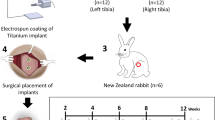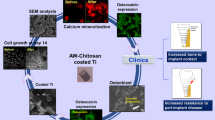Abstract
The aim of this study was to analyse the osseointegrative potential of phosphoserine-tethered dendrons when applied as surface functionalisation molecules on titanium implants in a sheep model after 2 and 8 weeks of implantation. Uncoated and dendron-coated implants were implanted in six sheep. Sandblasted and etched (SE) or porous additive manufactured (AM) implants with and without additional dendron functionalisation (SE-PSD; AM-PSD) were placed in the pelvic bone. Three implants per group were examined histologically and six implants were tested biomechanically. After 2 and 8 weeks the bone-to-implant contact (BIC) total values of SE implants (43.7 ± 12.2; 53.3 ± 9.0 %) and SE-PSD (46.7 ± 4.5; 61.7 ± 4.9 %) as well as AM implants (20.49 ± 5.1; 43.9 ± 9.7 %) and AM-PSD implants (19.7 ± 3.5; 48.3 ± 15.6 %) showed no statistically significant differences. For SE-PSD and AM-PSD a separate analysis of only the cancellous BIC demonstrated a statistically significant difference after 2 and 8 weeks. Biomechanical findings proved the overall increased stability of the porous implants after 8 weeks. Overall, the great effect of implant macro design on osseointegration was further supported by additional phosphoserine-tethered dendrons for SE and AM implants.









Similar content being viewed by others
References
Banerjee S, Issa K, Kapadia BH, Pivec R, Khanuja HS, Mont MA. Highly-porous metal option for primary cementless acetabular fixation. What is the evidence? Hip Int. 2013;23:509–21.
Götz W, Gedrange T, Bourauel C, Hasan I. Clinical, biomechanical and biological aspects of immediately loaded dental implants: a critical review of the literature. Biomed Tech (Berl). 2010;55:311–5.
Le Guéhennec L, Soueidan A, Layrolle P, Amouriq Y. Surface treatments of titanium dental implants for rapid osseointegration. Dent Mater. 2007;23:844–54.
Palmquist A, Omar OM, Esposito M, Lausmaa J, Thomsen P. Titanium oral implants: surface characteristics, interface biology and clinical outcome. J R Soc Interface. 2010;5:515–27.
Tomisa AP, Launey ME, Lee JS, Mankani MH, Wegst UG, Saiz E. Nanotechnology approaches to improve dental implants. Int J Oral Maxillofac Implants. 2011;26:25–44.
Richards RG, Moriarty TF, Miclau T, McClellan RT, Grainger DW. Advances in biomaterials and surface technologies. J Orthop Trauma. 2012;26:703–7.
Wennerberg A, Jimbo R, Stübinger S, Obrecht M, Dard M, Berner S. Nanostructures and hydrophilicity influence osseointegration: a biomechanical study in the rabbit tibia. Clin Oral Implants Res. 2013. doi:10.1111/clr.12213.
Junker R, Dimakis A, Thoneick M, Jansen JA. Effects of implant surface coatings and composition on bone integration: a systematic review. Clin Oral Implants Res. 2009;20:185–206.
Sjöström T, Brydone AS, Meek RM, Dalby MJ, Su B, McNamara LE. Titanium nanofeaturing for enhanced bioactivity of implanted orthopedic and dental devices. Nanomedicine (Lond). 2013;8:89–104.
Merolli A, Santin M. Role of phosphatidyl-serine in bone repair and its technological exploitation. Molecules. 2009;14:5367–81.
Santin M, Rhys-Williams W, O’Reilly J, Davies MC, Shakesheff K, Love WG, Lloyd AW, Denyer SP. Calcium-binding phospholipids as a coating material for implant osteointegration. J R Soc Interface. 2006;3:277–81.
Galli C, Piemontese M, Meikle ST, Santin M, Macaluso GM, Passeri G. Biomimetic coating with phosphoserine-tethered poly (epsilon-lysine) dendrons on titanium surfaces enhances Wnt and osteoblastic differentiation. Clin Oral Implants Res. 2013. doi:10.1111/clr.12075.
Meikle ST, Bianchi G, Olivier G, Santin M. Osteoconductive phosphoserine-modified poly({varepsilon}-lysine) dendrons: synthesis, titanium oxide surface functionalization and response of osteoblast-like cell lines. J R Soc Interface. 2013;10:20120765.
Langhoff JD, Voelter K, Scharnweber D, Schnabelrauch M, Schlottig F, Hefti T, Kalchofner K, Nuss K, von Rechenberg B. Comparison of chemically and pharmaceutically modified titanium and zirconia implant surfaces in dentistry: a study in sheep. Int J Oral Maxillofac Surg. 2008;37:1125–32.
Stübinger S, Biermeier K, Bächi B, Ferguson SJ, Sader R, von Rechenberg B. Comparison of Er:YAG laser, piezoelectric, and drill osteotomy for dental implant site preparation: a biomechanical and histological analysis in sheep. Lasers Surg Med. 2010;42:652–61.
von Rechenberg B, Leutenegger CM, Zlinszky K, McIlwraith CW, Akens MK, Auer JA. Upregulation of mRNA of interleukin-1 and 6 in subchondral cystic lesions of four horses. Equine Vet J. 2000;33:143–9.
Plecko M, Sievert C, Andermatt D, Frigg R, Kronen P, Klein K, Stübinger S, Nuss K, Bürki A, Ferguson S, Stoeckle U, von Rechenberg B. Osseointegration and biocompatibility of different metal implants—a comparative experimental investigation in sheep. BMC Musculoskelet Disord. 2012;13:32.
Auer JA, Goodship A, Arnoczky S, Pearce S, Price J, Claes L, von Rechenberg B, Hofmann-Amtenbrinck M, Schneider E, Müller-Terpitz R, Thiele F, Rippe KP, Grainger DW. Refining animal models in fracture research: seeking consensus in optimising both animal welfare and scientific validity for appropriate biomedical use. BMC Musculoskelet Disord. 2007;8:72.
Mills LA, Simpson AH. In vivo models of bone repair. J Bone Joint Surg Br. 2012;94:865–74.
Stübinger S, Dard M. The rabbit as experimental model for research in implant dentistry and related tissue regeneration. J Invest Surg. 2013;26:266–82.
Pearce AI, Richards RG, Milz S, Schneider E, Pearce SG. Animal models for implant biomaterial research in bone: a review. Eur Cell Mater. 2007;13:1–10.
Vignoletti F, Abrahamsson I. Quality of reporting of experimental research in implant dentistry. Critical aspects in design, outcome assessment and model validation. J Clin Periodontol. 2012;39:6–27.
Kimmel DB, Jee WS. A quantitative histologic study of bone turnover in young adult beagles. Anat Rec. 1982;203:31–45.
Trisi P, Todisco M, Consolo U, Travaglini D. High versus low implant insertion torque: a histologic, histomorphometric, and biomechanical study in the sheep mandible. Int J Oral Maxillofac Implants. 2011;26:837–49.
Jimbo R, Tovar N, Yoo DY, Janal MN, Anchieta RB, Coelho PG. The effect of different surgical drilling procedures on full laser-etched microgrooves surface-treated implants: an experimental study in sheep. Clin Oral Implants Res. 2013. doi:10.1111/clr.12216.
Tehemar SH. Factors affecting heat generation during implant site preparation: a review of biologic observations and future considerations. Int J Oral Maxillofac Implants. 1999;14:127–36.
Deporter D. Dental implant design and optimal treatment outcomes. Int J Periodontics Restorative Dent. 2009;29:625–33.
Al-Nawas B, Wagner W, Grötz KA. Insertion torque and resonance frequency analysis of dental implant systems in an animal model with loaded implants. Int J Oral Maxillofac Implants. 2006;21:726–32.
Witek L, Marin C, Granato R, Bonfante EA, Campos FE, Gomes JB, Suzuki M, Coelho PG. Surface characterization, biomechanical, and histologic evaluation of alumina and bioactive resorbable blasting textured surfaces in titanium implant healing chambers: an experimental study in dogs. Int J Oral Maxillofac Implants. 2013;28:694–700.
Jimbo R, Coelho PG, Bryington M, Baldassarri M, Tovar N, Currie F, Hayashi M, Janal MN, Andersson M, Ono D, Vandeweghe S, Wennerberg A. Nano hydroxyapatite-coated implants improve bone nanomechanical properties. J Dent Res. 2012;91:1172–7.
Acknowledgments
This work has been supported by Eurocoating SpA through the Provincia Autonoma of Trento grant, Biosintering project.
Author information
Authors and Affiliations
Corresponding author
Rights and permissions
About this article
Cite this article
Stübinger, S., Nuss, K., Bürki, A. et al. Osseointegration of titanium implants functionalised with phosphoserine-tethered poly(epsilon-lysine) dendrons: a comparative study with traditional surface treatments in sheep. J Mater Sci: Mater Med 26, 87 (2015). https://doi.org/10.1007/s10856-015-5433-3
Received:
Accepted:
Published:
DOI: https://doi.org/10.1007/s10856-015-5433-3




